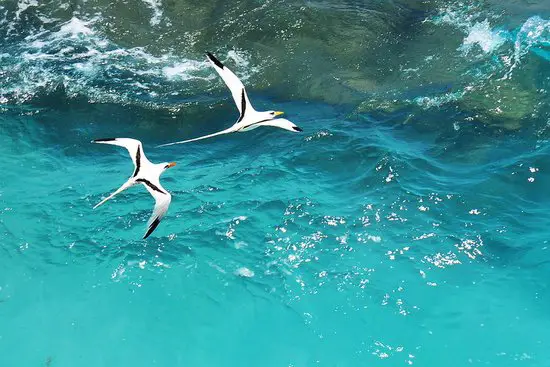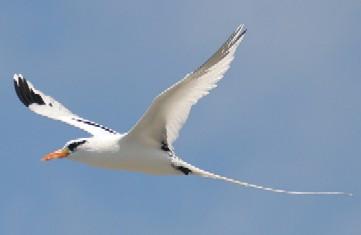Bermuda Longtails
White tailed tropic birds that are found in the tropical ocean areas are locally known in Bermuda as the Longtails. They have a long white feathered tail and a body with white and black marks. In Bermuda these birds are like a national symbol and their impressions can be seen on many things including on coins, jewelry, pottery and other craft work.
Bermuda Longtails
Photo: Kansasphoto/flickr, cc by 2.0
The birds come to shore between April and October for nesting. They nest in crevices and holes, and lay a single egg. When not breeding and during the winter they wander and fly far out into the ocean.
The birds plunge and feed on fish and squids. An average fully grown longtail would be some 70-80 cm long with a wing span of 85-95 cm. They have a black mark on the wing and also in the eye. The bill is yellow-orange in color. They make a high pitch sound like "kee kee krrt krrt krrt" and usually sleep on their wings or on the ocean water.
You can often see the males and females flying together in small groups as part of their mating ritual. Many believe that they are usually quite loyal towards each other and stay with the same mate lifelong and use their old nests repeatedly.
Bermuda Longtail (White Tailed Tropic Bird)
Photo Credit: Glen Tepke
However due to damages caused by the hurricanes and development along the coastline, their habitat is becoming fewer and the species is now under some threat. In 1978, there used to be some 3,000 birds that used to nest along Bermuda's coastline. Over time, their numbers have declined steadily. However there is finally a good news. The Bermuda Longtails now have such an exclusive resort of their own that even human beings are not allowed there.
Surprised? It's true.
Bermuda Maritime Museum is now building up a series of igloos for the Bermuda Longtail birds to help them nest. The authorities at the BMM decided to experiment with providing private nesting areas for the birds.
There are some 20 igloos that have been built so far for the birds. An unused bastion in the fort area where BMM is located, is used for this purpose. The igloos are set up along the ramparts.
However, due to continuous flow of human visitors, the privacy of the birds are jeopardized. There is a plan to put up a Plexiglas so that the curious visitors can see the igloos from outside.
There is also a plan to set up a video camera so that visitors can see online what the birds are doing. But, the housing of the longtail birds require financial assistance. BMM is reaching out to the bird lovers and asking them to lease out the igloos to help sustain the project.
The current lease rate is $100 for a year, $300 for 5 years, and $5000 for a life time igloo. Their actual advertisement says: "Exclusive deeded fractional, time-and-nest-share ownership club with breathtaking sea-views of the Atlantic Ocean. No neighbors, except of your own kind... as in 'birds of a feather flock together'..." .
Contacts for further info
For more information about the bird igloos, contact the Bermuda Audubon Society.
To subsidize nesting of longtail at the BMM, Email
[email protected] or phone 441/704-5480.
Update 2012
One of the main threats of the Bermuda longtails are destruction of the natural nests along the coast line due to strong wave actions and hurricanes. Bermuda Department of Conservation has recently taken up an initiative to create artificial nests along the coast where there have been large scale damages of the natural nests. The results have been extremely encouraging. In fact it has been observed that in the artificial nests, the birds readily breed and the success rate is 74% compared to 66% in natural nests.
Related Articles
1. Check out
Bermuda Birds to know about all the birds in Bermuda and the best bird watching locations in the island.

